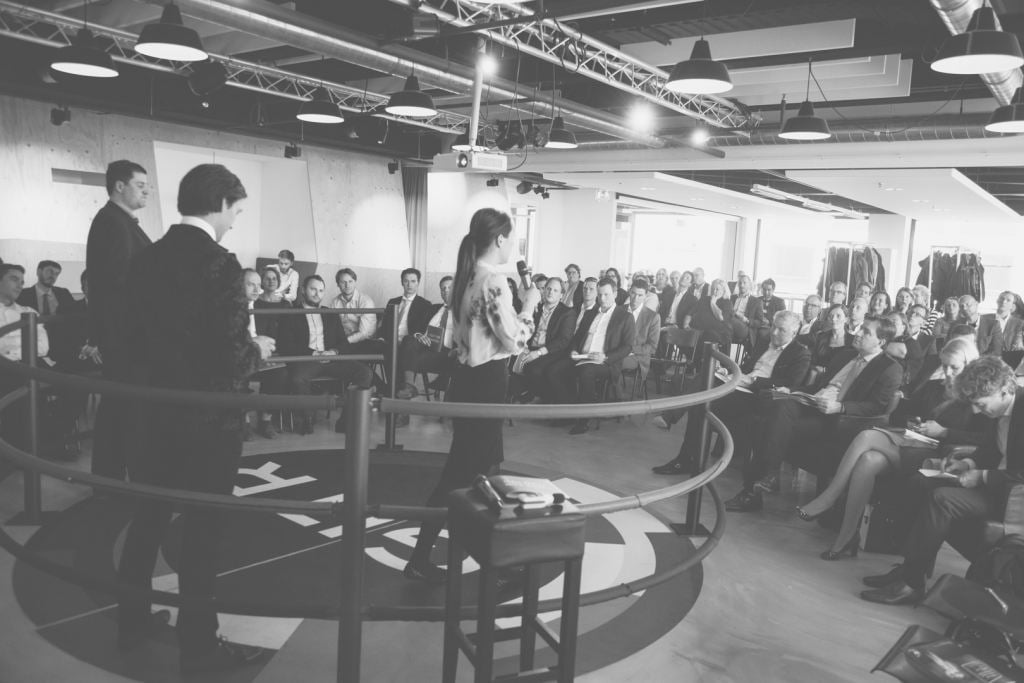
Startups often have the same challenges as large multinationals, only usually they lack the money – and a large organization – to face them. Foreign employees who need a visa, legal and tax hassles, separate salary structures: all aspects that – though important – distract the starters from the real entrepreneurship. EY, a global player in the field of accountancy and taxes, decided to attack the problem by bringing in a special team with a strong focus on startups. Lower rates, a subscription instead of paying for each question, and even a special guidance. This was five years ago.
One thing led to another. Along with Guus Frericks, now CEO of HighTechXL, a program was devised with the primary goal to support startups in the high tech hardware sector: Startup Factory Eindhoven. The Factory became a bootcamp and the bootcamp became HighTechXL. But meanwhile, EY began to see that the service it provided to other startups, could also be useful for EY itself.

Broos Bakens, who along with colleague Patrick Gabriëls helped set up HighTechXL right from the start, sees that his sector is also awaiting huge disruptions. “Even we face our challenges with innovation. New data-driven services such as robotic accounting and other automations surely will change our work. At the same time we see that we have a lot of tremendously talented people whom we can’t guarantee that they can continue doing their current job. ”
The solution was obvious, Gabriëls and Bakens saw: “We just had to counter the trends, so we started off with our own innovation program. Emphatically also because of the desire to offer our talents at EY new opportunities”, Bakens says. And so began an innovation track that required an investment from both the employee and the employer. This double investment would remove non-commitment, but also show how EY wanted to make serious efforts.
To stay on the right track, Gabriëls and Bakens designed a program with four phases. In the beginning, the employee has to invest a lot of his spare time in the project, at the end it is primarily the employer who does.
Step 1: Ideation
In this phase, the most important thing is to show that there is a feasible idea. But also the team must be formed. Beacons: “At this point we make good use of the learnings from the HighTechXL accelerator in recent years. Therefore we know basically everything about the importance of the right composition of the team and we select on intrinsic motivation within the team. An idea may seem strong, but without the proper composition of the team behind it, it’s nothing. “This is also the stage where we see that the product or service may change substantially as a result of discussions with potential clients and customers. The ideation phase is concluded with a pitch contest: only the best can proceed to step two.
Step 2: Concept
Through the method of the lean startup we make the first steps to build a business model. Bakens: “This is similar to what we do in the first phase of HighTechXL: the concept should be given focus and above all be validated. In the Battle of Innovation, all your assumptions must get validation.” This phase lasts about three months and still, the participants will have to invest a lot of their own time, although EY also offers hours.

Step 3: The Startup
Who has survived the Battle of Innovation, is ready for the real thing: a working product now has to be built. The first three teams from the program have reached this point. They were ‘released’ last week to the world outside EY and must now show that their idea can actually generate new business. It’s no coincidence that they received a spot in HighTechXL, Frericks’s accelerator at the High Tech Campus where EY still plays an important role. Bakens: “We have deliberately chosen not to do this in-house. That would be the fastest way to kill the product in advance. You know how it is: there are always reasons to be distracted by the ‘normal’ work, or you’ll suffer from colleagues who want to get involved. So this phase just had to be performed elsewhere. The choice was easy: where else than at HighTechXL?”
The three teams are now fully part of the HighTechXL accelerator, even though none of them really work on high-tech hardware products. Bakens: “The program is slightly modified, but for the most part this is not necessary. The emphasis is on building the business, not on the hardware itself.”
Step 4: Scaleup
After three months in the accelerator it will be time to go to market with the new business. “Now it really comes down to peformance. Will they get sufficient funding to continue to build? Now new business has to develop.”
The three EY teams in HighTechXL are working on products that are an extension of the core business within EY itself.
- A dashboard that allows banks and insurance companies to arrange their reporting to official bodies,
- an online tool for startups and investors with a financial model that clarifies what the consequences of certain actions look like,
- and a database solution to avoid double processes in tax, statutory and management reports when operating in various countries.
Although the process has been set up to ignite new business opportunities for EY in the future, this process could also be a new business in itself. “Indeed so,” Bakens syas. “But step by step. First we have to develop it further. It’s a matter of iterating, and in that sense we are just like any real startup. We’re already getting enthusiastic reactions from other corporates and we’re sure that eventually we’ll have a product that can work for others as well. I’d love to roll it out like that. But always in collaboration with HighTechXL.”

